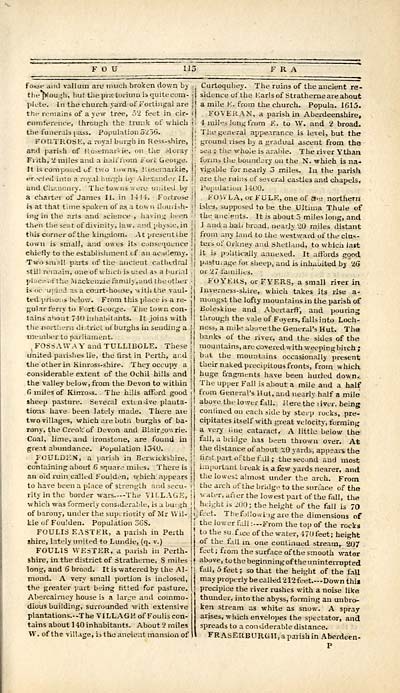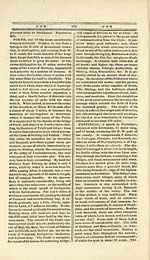Gazetteer of Scotland
(115) Page 113 - FOR
Download files
Complete book:
Individual page:
Thumbnail gallery: Grid view | List view

F O U
fosse anil vallum are much broken down by ;,
the^pNou-jh, but theprartoriuinisquitecom- jj
plete. In the church yard of Fortingai are j j
the remains of a yew tree, 52 feet in cir- i|
cumtereuoe, through the trunk of which I.
tiie funetals pass. Population o'^j'j.
FORTROSE, a royal burgh in Ross-shire, j;
and parish of Rosernarkie, on tiie Moray i :
Frith, 2 miles and a ban from Fort George.
It is composed of two hums, l.user.iaikie, 1!
er.vieii in:o a rov.il burgh by Alexander II. R
and Chanonry. TheW«-weBj united by ,;
a charter of James II. in 1411. Fortrose lj
is at that time spoken of as a tou n t'.ju.idi- \<
ing in the nrls and science , having been ; !
then the seat of divinity, law. and physic, in j j
this corner of the kingdom. At present the i|
town is small, and owes its consequence !i
chiefly to the establishment cf an academy. |
Two small parts of the ancient cathedral [j
still remain, one of which isuied as a hurl;
j>l;iC!-.!i the Mackenzie family, and the otiit
is oc .-upied as a court-house, with the vau.
ted.prisons below. From this place is a re- j I
gular ferry to Fort George. The town con- |
tains about T-KI inhabitants. It joins with I
the northern district ofburghs in sending a 1 1
member to parliament.
, FOSSAWA Y and TULLIBGLE. These j|
united parishes lie, the first in Perth, and j j
the other in Kinross-shire. They occupy a
considerable extent of the Ochil hills and
the valley below, from the Devon to within
(i miles of Kinross. - The hills afford good
sheep pasture. Several extensive planta-
tions have been lately made. There aie
two villages, which are both burghs of ba-
rony, the Crook of Devon and Blairgow rie.
Coal, lime, and ironstone, are found in
great abundance. Population 1340.
FOULDEN, a parish in Berwickshire, 1
containing about 6 square miles. There is I j
an oid ruin called Foulden, which appears j j
to have been a place of strength and secu- i j
rityinthc border wars— -The VILLAGE, jj
which was formerly considerable, is a burgh
of barony, under the superiority of Mr Wil-
kie of Foulden. Population 3GS.
FOULIS EASTER, a parish in Perth
shire, lately united to Lundie, (q. v.)
FOULIS WESTER, a parish in Perth-
shire, in the district of Stratherne, 8 miles
long, and 6 broad. It is watered by the Al-
mond. A very small portion is inclosed,
the greater part being fitted for pasture. !
Abercaimey house is a large and commo-
dious building, surrounded with extensive
plantations.--The VILLAGE of Foulis con-
tains about 140 inhabitants. About 2 miles
W. of ths village, ia the ancient mansion of
F R A
Curtoquhey. The rums of the ancient re-
sidence of the Earls of Stratherne are about
a mile K. from the church. Popula. 1615.
FOVERAN, a parish in Aberdeenshire,
4 miles long from E. to W. and 2 broad.
The general appearance is level, but. the
ground rises by a gradual ascent from the
:>ea ; tiie whoie is arable. The river Ythan
forms the boundary on the N. which is na-
vigable for nearly 3 miles. In the parish
are tile rui:is cf several castles and chapels.
Population 1400.
FOWLA, orFULF., one of a.e northern
isles, supposed to be the Ultima Thule of
the ancients. It is about 3 miles long, and
I andahal, broad, nearly 20 miles distant
from any land to the westward of the clus-
ters of Orkney and Shetland, to which last
it is politically annexed. It affords good
pastuiage for sheep, and is inhabited by 26"
or 2 7 families.
FOYERS, or FYERS, a smalV river in
Inverness-shire, which takes its rise a-
mongst the lofty mountains in the parish of
Boleskine and AbertarfK, and pouring
through the vale of Foyers, falls into Loch-
ness, a mile above the General's Hut. Tha
banks of the river, and the sides of the
mountains, are coveredwithweepingbirch;
bat the mountains occasionally present
their naked precipitous fronts, from which,
huge fragments have been hurled down,.
The upper Fall is about a mile and a half
from General's Hut, and nearly half a mile
above the lower fall. Here the liver, being
confined on each side by steep rocks, pre-
cipitates itself with great velocity, forming
a very line cataract. A little below the
fall, abridge has been thiown over. At
the distance of about 20 yards, appears the
first part of the fall ; the second and most
important break is a few yards nearer, and
the lowest almost under the arch. From
the arch of the bridge to the surface of the
water, after the lowest part of the fall, the
height is -00; the height of the fall is 70
feet. Thefollowiig are the dimensions of
the lower fall :— From the top of the rocks
to the su.f lC e of the water, 470feet; height
of the fall in one continued stream, 207
feet; from the surface of the smooth water
above, to the beginning of the uninterrupted
fail, 5 feet ; so that the height of the fall
may properly be called212feet.— Down this
precipice the river rushes with a noise like
thunder, into the abyss, forming an unbro-
ken stream as white as snow. A spray-
arises, whicii envelopes the spectator, and
spreads to a considerable distance.
FRASERBURGH, a parish in Aberdeen-
fosse anil vallum are much broken down by ;,
the^pNou-jh, but theprartoriuinisquitecom- jj
plete. In the church yard of Fortingai are j j
the remains of a yew tree, 52 feet in cir- i|
cumtereuoe, through the trunk of which I.
tiie funetals pass. Population o'^j'j.
FORTROSE, a royal burgh in Ross-shire, j;
and parish of Rosernarkie, on tiie Moray i :
Frith, 2 miles and a ban from Fort George.
It is composed of two hums, l.user.iaikie, 1!
er.vieii in:o a rov.il burgh by Alexander II. R
and Chanonry. TheW«-weBj united by ,;
a charter of James II. in 1411. Fortrose lj
is at that time spoken of as a tou n t'.ju.idi- \<
ing in the nrls and science , having been ; !
then the seat of divinity, law. and physic, in j j
this corner of the kingdom. At present the i|
town is small, and owes its consequence !i
chiefly to the establishment cf an academy. |
Two small parts of the ancient cathedral [j
still remain, one of which isuied as a hurl;
j>l;iC!-.!i the Mackenzie family, and the otiit
is oc .-upied as a court-house, with the vau.
ted.prisons below. From this place is a re- j I
gular ferry to Fort George. The town con- |
tains about T-KI inhabitants. It joins with I
the northern district ofburghs in sending a 1 1
member to parliament.
, FOSSAWA Y and TULLIBGLE. These j|
united parishes lie, the first in Perth, and j j
the other in Kinross-shire. They occupy a
considerable extent of the Ochil hills and
the valley below, from the Devon to within
(i miles of Kinross. - The hills afford good
sheep pasture. Several extensive planta-
tions have been lately made. There aie
two villages, which are both burghs of ba-
rony, the Crook of Devon and Blairgow rie.
Coal, lime, and ironstone, are found in
great abundance. Population 1340.
FOULDEN, a parish in Berwickshire, 1
containing about 6 square miles. There is I j
an oid ruin called Foulden, which appears j j
to have been a place of strength and secu- i j
rityinthc border wars— -The VILLAGE, jj
which was formerly considerable, is a burgh
of barony, under the superiority of Mr Wil-
kie of Foulden. Population 3GS.
FOULIS EASTER, a parish in Perth
shire, lately united to Lundie, (q. v.)
FOULIS WESTER, a parish in Perth-
shire, in the district of Stratherne, 8 miles
long, and 6 broad. It is watered by the Al-
mond. A very small portion is inclosed,
the greater part being fitted for pasture. !
Abercaimey house is a large and commo-
dious building, surrounded with extensive
plantations.--The VILLAGE of Foulis con-
tains about 140 inhabitants. About 2 miles
W. of ths village, ia the ancient mansion of
F R A
Curtoquhey. The rums of the ancient re-
sidence of the Earls of Stratherne are about
a mile K. from the church. Popula. 1615.
FOVERAN, a parish in Aberdeenshire,
4 miles long from E. to W. and 2 broad.
The general appearance is level, but. the
ground rises by a gradual ascent from the
:>ea ; tiie whoie is arable. The river Ythan
forms the boundary on the N. which is na-
vigable for nearly 3 miles. In the parish
are tile rui:is cf several castles and chapels.
Population 1400.
FOWLA, orFULF., one of a.e northern
isles, supposed to be the Ultima Thule of
the ancients. It is about 3 miles long, and
I andahal, broad, nearly 20 miles distant
from any land to the westward of the clus-
ters of Orkney and Shetland, to which last
it is politically annexed. It affords good
pastuiage for sheep, and is inhabited by 26"
or 2 7 families.
FOYERS, or FYERS, a smalV river in
Inverness-shire, which takes its rise a-
mongst the lofty mountains in the parish of
Boleskine and AbertarfK, and pouring
through the vale of Foyers, falls into Loch-
ness, a mile above the General's Hut. Tha
banks of the river, and the sides of the
mountains, are coveredwithweepingbirch;
bat the mountains occasionally present
their naked precipitous fronts, from which,
huge fragments have been hurled down,.
The upper Fall is about a mile and a half
from General's Hut, and nearly half a mile
above the lower fall. Here the liver, being
confined on each side by steep rocks, pre-
cipitates itself with great velocity, forming
a very line cataract. A little below the
fall, abridge has been thiown over. At
the distance of about 20 yards, appears the
first part of the fall ; the second and most
important break is a few yards nearer, and
the lowest almost under the arch. From
the arch of the bridge to the surface of the
water, after the lowest part of the fall, the
height is -00; the height of the fall is 70
feet. Thefollowiig are the dimensions of
the lower fall :— From the top of the rocks
to the su.f lC e of the water, 470feet; height
of the fall in one continued stream, 207
feet; from the surface of the smooth water
above, to the beginning of the uninterrupted
fail, 5 feet ; so that the height of the fall
may properly be called212feet.— Down this
precipice the river rushes with a noise like
thunder, into the abyss, forming an unbro-
ken stream as white as snow. A spray-
arises, whicii envelopes the spectator, and
spreads to a considerable distance.
FRASERBURGH, a parish in Aberdeen-
Set display mode to: Large image | Transcription
Images and transcriptions on this page, including medium image downloads, may be used under the Creative Commons Attribution 4.0 International Licence unless otherwise stated. ![]()
| Gazetteers of Scotland, 1803-1901 > Gazetteer of Scotland > (115) Page 113 - FOR |
|---|
| Permanent URL | https://digital.nls.uk/97423074 |
|---|

